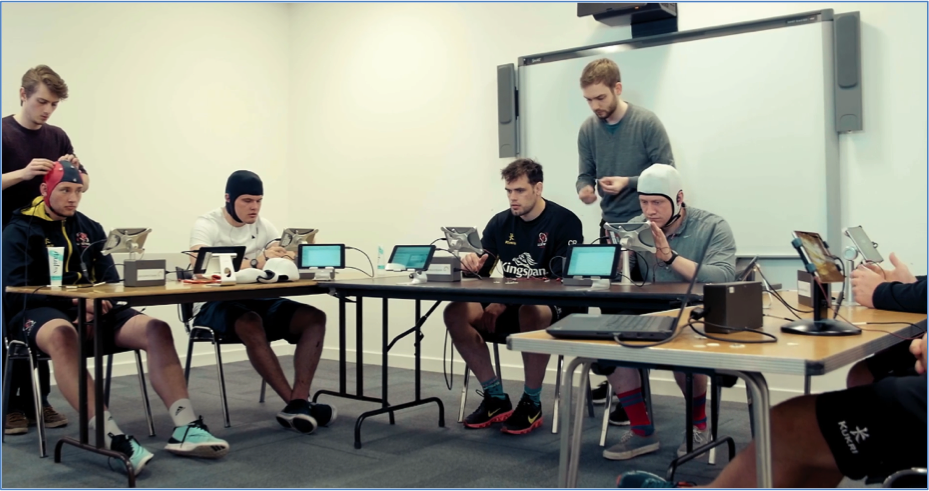- Home
- About ANT
-
Products

asa
asa is a highly flexible EEG/ERP and MEG analysis package with a variety of source reconstruction, signal analysis and MRI processing features.
.jpg)
eego mylab
The new frontier in multimodal brain research. With up to 16 kHz sampling rate, 256 EEG channels and unique software features, eego mylab gives you an unprecedented in-depth understanding of the human brain.

eego sports
eego sports offers complete freedom to collect high-density EEG data, bipolar EMG signals, and a variety of physiological sensor data, wherever and whenever required, with publish quality data in less than 15 minutes!

waveguard net
The waveguard net sets a new standard for research applications requiring high-density EEG data acquisition with quick preparation time, high flexibility, and subject comfort.

visor2
Our new and upgraded visor2 solutions integrate all the latest technologies for navigated rTMS, dual-coil navigation support, EEG-TMS recordings and pre-surgical evaluation for the highest quality in research and clinical procedures.

powerMAG ANT
The PowerMAG ANT 100 rTMS stimulator is designed for the specific needs of high-end TMS applications. Powerful high-frequency TMS as well as high precise single pulse and repetitive pulse protocols are combined in one single device.

xensor
xensor offers the solution for digitization of 3D electrode positions. xensor takes care of the whole procedure; it records, visualizes and stores positions acquired with a dedicated digitizer.

waveguard original
waveguard original is the cap solution for EEG measurements compatible with fMRI, MEG and TMS system. Use of active shielding guarantees performance in even the most demanding environments.

waveguard connect
waveguard connect EEG caps are a perfect match for hospitals and institutes aiming at reliable EEG, maximum uptime and great patient comfort! For optimal signal quality, the electrodes are made of pure, solid tin.

waveguard touch
waveguard touch is a dry electrode EEG cap. The unique Ag/AgCl coated soft polymer electrodes provide stable, research-grade EEG signals while maintaining subject comfort. The combination of these innovative dry electrodes and the industry-leading waveguard cap makes waveguard touch the best solution for dry EEG.

smartmove
smartmove allows planning of a complete TMS session ahead by defining stimulation sites based on anatomical MRI information and functional information like fMRI, PET or EEG/MEG.
Stay - References
- Support
- Events
- News
- Contact Us
You are here
Monitoring rugby players’ cognitive performance using dry EEG electrodes
Monitoring rugby players’ cognitive performance using dry EEG electrodes

Dr. Brian Murphy from Belfast-based start-up BrainWaveBank Ltd. is currently working on a neuro-monitoring project together with Ulster Rugby, a professional rugby club based in Belfast. Ulster Rugby, under the direction of Head of Athletic Performance, Jonathan Davis, highly values their players’ performance and wellbeing. Their sport science team lead by David Drake already have well-developed models to monitor players’ athletic performance and physical wellbeing. They would now like to deepen their understanding of their players’ cognitive performance and have joined forces with BrainWaveBank.
Between training sessions and matches, the professional rugby players only have very limited time available for the EEG monitoring sessions. In order to minimize setup and application time whilst ensuring high quality EEG recordings, the waveguard touch and eego 8 amplifier were chosen for this study.

Figure 1: The rugby players performing tests whilst wearing the waveguard touch.
Set-up of study
Participants in this study are professional rugby players from Ulster Rugby. Based on availability of individual players, a total of 10-15 players are monitored each week. The EEG recordings are repeated between 2 - 4 times a week.
A two-stimulus oddball test (Linden, 2005) is used to measure speed and accuracy of reactions and decision-making of individual players. A Flanker test is administered to assess inhibition and error awareness (Eriksen & Eriksen, 1974). Behavioral measures are combined with event-related EEG metrics to provide a broad picture of cognitive health (Hillman, Kamijo & Pontifex, 2012). Eyes-open and an eyes-closed resting state EEG are recorded as a psychological measure of mental alertness (Stampi, Stone & Michimori, 1995).
Systematic qualitative and quantitative information regarding training, playing and lifestyle are collected using a variety of devices including GPS technology via Statsports, a wrist activity tracker used to measure sleep and self report questionnaire (containing questions regarding caffeine intake, mood, sleep quality etc.).
Six eego 8 systems are in use for this study. Six participants can be tested at the same time and the full sessions recordings are collected within 20 minutes.
Analysis
Data collection has just concluded. Though analysis is ongoing, we already see some clear effects of sleep, and training, and perceived well-being on behavioral and EEG based measures of cognitive performance. Ultimately, BrainWaveBank aims to develop models for measuring and actively optimizing cognitive preparedness for competitive matches.
For more information about BrainWaveBank and Ulster Rugby, please visit https://www.brainwavebank.com or contact jonathan.davis@ulsterrugby.com.
Related publications
- Eriksen, B.A., Eriksen, C.W. (1974). Effects of noise letters upon the identification of a target letter in a nonsearch task. Perception & Psychophysics 16(1) 143-149.
- Hillman, C. H., Kamijo, K., & Pontifex, M. B. (2012). The Relation of ERP Indicies of Exercise to Brain Health and Cognition. In C. H. Hillman, L. Scheef, & H. K. Struder (Eds.), Functional Neuroimaging in Exercise and Sport Sciences (pp. 419–446). New York, NY.
- Linden, D. E. J. (2005). The P300: Where in the Brain Is It Produced and What Does It Tell Us? The Neuroscientist, 11(6), 563–576. https://doi.org/10.1177/1073858405280524
- Stampi, C., Stone, P., & Michimori, A. (1995). A new quantitative method for assessing sleepiness: The alpha attenuation test. Work & Stress, 9(2–3), 368–376. https://doi.org/10.1080/02678379508256574

 Read more
Read more.jpg)




